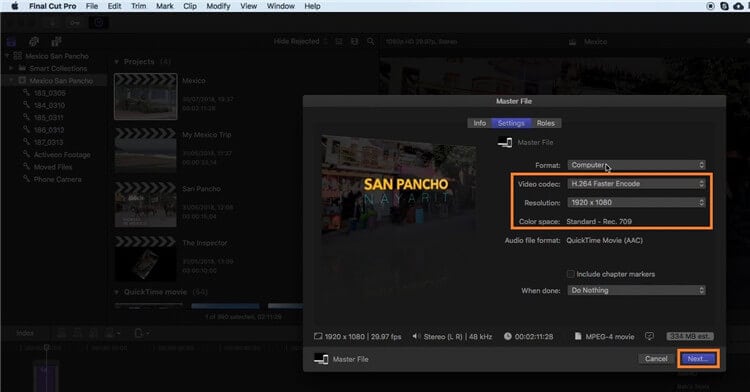
- #Final cut pro video formats how to
- #Final cut pro video formats pro
- #Final cut pro video formats software
You won’t need to render your video project before finalizing it and exporting it. Do I Need To Render My Video Before Exporting in Final Cut Pro?
#Final cut pro video formats pro
On outdated computers, editors using Final Cut Pro may want to stick with the default rendering settings to avoid lengthy rendering times. The best rendering settings for Final Cut Pro depend on the type of video files you’re working with, as well as your computer’s hardware. What Is the Best Rendering for Final Cut Pro? Users can also adjust these settings, ensuring that video quality is unaffected. But Final Cut Pro uses a high rendering bitrate by default.

#Final cut pro video formats software
Of course, video editing software that uses a low rendering bitrate can decrease the original video’s quality. For example, you may notice that the original resolution of your video file is significantly decreased or that frames are missing. Your videos and images should retain their original resolution and quality when the rendering process is complete. During the rendering process, the previewable video may be less-than-stellar.
#Final cut pro video formats how to
If you are looking to learn how to keyframe video in Final Cut Pro, check out our Complete Guide to Keyframing in Final Cut Pro. Rendering times don’t often affect project finalization and video exportation. Still, editors can continue to work on projects while their media renders with the background rendering feature. Larger, higher-resolution videos tend to take the longest to render, especially for those working on low-performance devices. The time it takes to render a video in Final Cut Pro varies depending on the size of the video, the quality of the video, and your computer’s hardware and specs. How Long Does Rendering a Video Take in Final Cut Pro? Trying to mask video in Final Cut Pro and struggling? You need to read our Complete Guide to Masking Video in Final Cut Pro. Essentially, the purpose of video rendering is to make digital images viewable. Without video rendering, editors need to use timestamps or have in-depth coding knowledge to alter videos and images. The video and image files on your computer or smartphone are essentially a form of data. Video rendering transforms digital data into viewable images and frames. Looking to master working with video clips in Final Cut Pro? We have you covered with our Ultimate Guide to Working with Video Clips in Final Cut Pro. Or you can use the keyboard shortcut Ctrl+Shift+R. Rendering all clips within the timeline is just as simple and utilizes the ‘Modify’ menu. If you’d rather use a keyboard shortcut to render a single clip, you can press Ctrl+R.

Ali does a great job of layering in each concept in a very easy-to-learn way that will have you becoming a Final Cut Pro ninja in no time. I personally recommend Ali Abdaal’s Video Editing with Final Cut Pro X course.

Video Editing with Final Cut Pro X course on SkillShareĪ beginners guide to Premiere Pro: Learn Premiere Pro in 15 minutes SkillShare offers a ton of great courses you can take for one low monthly fee. If you are looking to master Final Cut Pro or any other applications in the video editing space, I highly recommend that you check out SkillShare. You can use this information to improve your editing skills, create higher-quality videos, and speed up the editing process. This guide will explore all aspects of video rendering in Final Cut Pro. Video rendering allows Final Cut Pro users to translate data into images, making it easy to trim videos, add effects, and insert text within the editing timeline. In addition, this popular application utilizes video rendering processes to make video editing faster and simpler.įinal Cut Pro utilizes background video rendering to create temporary video and audio files that editors can manipulate and alter. Final Cut Pro is an Apple iOS video editing program that features an intuitive user interface and a comprehensive set of tools.


 0 kommentar(er)
0 kommentar(er)
